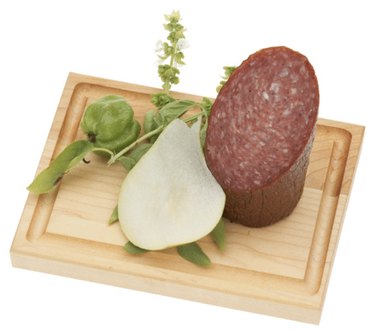
Mold often develops on foods such as lunch meat and hard salami. While some forms of mold are not harmful, others contain dangerous mycotoxins that can make you sick if they are inhaled or ingested. Mold can have thin roots growing all throughout the food, so the food should be thrown away to avoid adverse health effects. Some types of salami are safe to eat after mold is wiped away.
Identification
Video of the Day
Mold is microscopic fungi that reproduces by spores that are carried on the wind, by insects or through water. Many cells are present in mold and the body of mold on food includes root threads, a stalk and reproductive spores on the stalks. When your food molds, the spores are responsible for the color of the mold. Mold may be only on the surface of food or it can have deep root threads inside the food. Around these root threads is where toxic substances are found.
Video of the Day
Effects
Salami that has mold may have fuzzy growth in the surface. Foods that are salty or have high sugar contents such as salami, bacon and bologna often develop mold even in the cold temperatures inside your refrigerator. According to the United States Department of Agriculture, some types of mold can cause allergic reactions and respiratory problems. Mycotoxins are poisonous substances that can cause serious illnesses in certain people.
Potential
Some types of salami such as Italian or Eastern European salami have a coating of mold on them at purchase time that are safe to consume. Many hard salamis that develop mold are safe to consume after wiping or scrubbing the mold from the surface of the meat. Do not consume any food that has foul-smelling mold. Salami and other dry cured meats have a high content of sodium that keeps their shelf-stable even if a light coating of mold is visible on the surface.
Warning
Any food that has a high moisture content such as soft cheeses, yogurt and sour cream may have mold growth beneath the surface. Discard these types of foods with mold growth. Jams, jellies, bread, cooked meat, poultry, bacon, lunch meat, hot dogs and cooked food stored in the refrigerator should also be discarded. Hard salami and hard cheeses are safe to eat after mold is removed. Avoid sniffing or smelling the mold on food items, as this can cause allergic reactions in sensitive people.